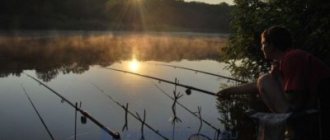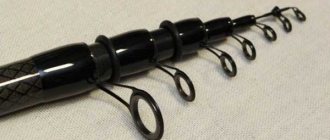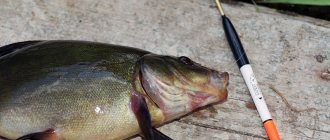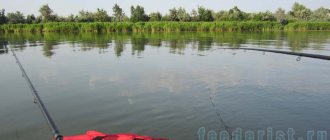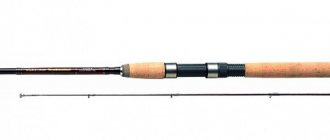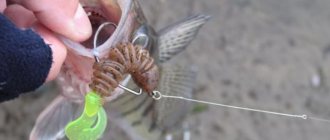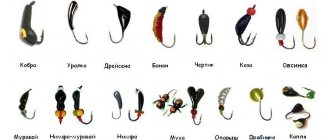All novice fishermen, as a rule, begin their careers with a float rod . I, too, am no exception and, like everyone else, I started with it - a hazel rod, a fishing line, a goose feather float, a shot and the hook itself. Then there was a two-legged bamboo, and finally all kinds of telescopic fishing rods, fortunately you can buy them inexpensively and for every taste
A float rod serves as a universal fishing tool. It is a convenient, elegant piece of equipment. This tackle is mainly amateur and sports. With its help, with appropriate re-equipment, you can catch almost any fish in central Russia. A fishing rod with a float can be used to fish from the shore and from a boat, in still and running water, in shallows and at depth. It can be used immediately after the opening of the river and before freeze-up. The design of a float rod is not very complicated. It can be built at home. A float rod consists of a hook, line, leash, sinker, float and rod.
Components of a float rod
Hook for float rod
The hook is an important part of fishing equipment. The success of fishing depends on its quality. It should be inconspicuous, durable, sharp enough and tenacious. A good hook springs when you try to straighten it with your hands. There are many varieties of this gear.
But which hook is best for rigging a float rod? Practice shows that single, single-flex hooks are in greatest demand. The length of their fore-end exceeds the width of the hook no more than twice. The ring head is bent inward. Of course, the choice of hook in size and shape depends on the method, fishing conditions, what kind of fish the angler wants to catch, and what kind of bait he intends to use.
For example:
- if the bait is grains of wheat or pearl barley, then it is better to use a hook No. 3-4;
- If you use an earthworm or pieces of boiled potatoes when fishing, then a No. 10 hook with a long shank is suitable.
Selection of hook depending on the type of fish:
- the smallest fish, fry - No. 1-3;
- crucian carp, bleak, roach, small bream - No. 4-6;
- carp, carp, asp, bream - No. 7-10;
- pike perch, catfish, barbel - No. 10-15.
When selecting hooks, it must be taken into account that inconspicuous tackle always has an advantage.
Fishing for carp, bream, tench on top
A few words about carp (including tench and bream). In May, these fish (again before spawning) stick to shallow bays with developed coastal vegetation. Sometimes, if you don’t make any noise, you can watch how a large fish, like a “submarine,” floats up and warms itself at the surface.
The slightest movement on the shore, and the submarine sinks. Catching turns into a hunt for a specific specimen. And in this case, a water-filled transparent float can help. I proceed as follows:
- Having noticed from the landmarks on the shore the point at which the specimen I’m interested in floats up, I throw the equipment described above to the area of the fishing point, but as far as possible;
- After this, I pause for a few minutes so that all the fish in the pond calm down. Exactly all of them, since large fish perfectly perceive the general mood;
- Then I slowly pull the equipment to the fishing point and hope for a bite.
It must be taken into account that carp rises to the surface after being disturbed after a certain time: sometimes after a minute, and sometimes after five. You will almost certainly deceive the fish if the bait hits the fishing point at the moment when the fish surfaces. The probability of such an event is not so small if you are observant and the fish is active.
Leash for float rod
A leash is used to make the tackle near the hook and bait less noticeable, in order to protect the line from breaking when it touches or strongly resists the fish.
Experienced anglers strive for the smallest leader thickness. But it must be commensurate with all the gear. The length of the leash depends on the fishing method. It is better to paint the leash in a color that is suitable for the fishing conditions. On a float fishing rod, the most practical are leashes with a length of 20-25 cm and a thickness of 0.10-0.12 mm less than the thickness of the main fishing line.
Sinker for float rod
The simplest sinker is a lead shot. Beginner fishermen should be warned against using various random objects (nuts, nails) as sinkers. They disrupt the harmony of the gear and lead to a poor catch. The best forms of sinkers for float fishing rods are shot, spindle-shaped and “stalk”. Lead is used to make them.
Lures for catching pike in the grass
When fishing from the surface, the choice of bait is of great importance. In spring, crucian carp are usually satisfied with maggots or a piece of worm. With carp and bream it’s more difficult. When hunting for carp, I use either maggot or white bread as bait.
If you can put the bait directly under the fish’s nose, then there is nothing better than a worm. By the way, floating bread as bait remains relevant all summer. Fishing for crucian carp and other carp fish with a water-filled float is very interesting in essence. High-speed “bleak” fishing for bottom fish from the surface is great!
When fishing in thickets, standard spinning baits with open hooks quickly collect grass on themselves. If you use an insufficiently strong fishing line, fishing with them may end in a dead hook, after which the equipment will have to be torn off.
Fishing with a sliding float
When fishing conditions require long-distance casting of bait, tackle with a sliding float is used. This type of tackle can be used when fishing for predatory fish using live bait or frogfish.
Before you start fishing, it is necessary to measure the depth at the intended fishing location as accurately as possible. On the main line, a stop is made for the float, corresponding to the depth. Then the float is released to the stop weight, the hook is baited and, grabbing the fishing line with your free hand above the float, they make a smooth cast forward and slightly upward so that when the sinker and float fall on the water, they avoid a jerk from the stretched fishing line. When using gear with a sufficient supply of fishing line, there is no jerk and the bait can be preserved. If, on the contrary, you have to use a fishing line that is too long, then to avoid problems when fishing, use a spinning reel. It is only necessary to ensure that the float release depth limiter passes freely through the passage rings and does not interfere with casting the tackle.
Features of fishing when using a sliding leash.
After a wide and sharp hook, you need to bring the fish towards you, quickly reeling the line onto the reel. When the remaining line does not exceed the length of the rod, stop reeling and act as a regular float rod.
Plumb fishing
330. Plumb fishing is used only in certain cases and at certain times. Fishing places: deep reaches, snags, places with silted bottom, rocky ridges. It is best to fish vertically in the spring, after the water has receded, and in the fall, when the aquatic vegetation has sank to the bottom.
331. For vertical trolling, the length of the rod can vary from 50 cm to 1.5 meters. The top should be hard. When fishing vertically from the shore, use a rod up to 4-5 meters long, preferably with a reel. The thickness of the line depends on the size of the fish you are catching, as well as the weight of the bait. It is better to take silk fishing line. Prepare a spinner for vertical fishing from tin or non-ferrous metals (from 1.5 to 7 cm). Stock up on a single, double or treble hook with red wool. When fishing vertically, you can equip the fishing rod with two hooks on separate leashes, in addition, one of them should be 5-7 cm longer than the other. Select a sinker in the form of a lead tube. Make a hole in the center of the sinker across the axis. Pass the leads through the opposite ends of the tube with an exit through the hole made.
332. Plumb fishing has its own characteristics. The bait sinks vertically to the bottom, then it is gradually pulled up to the upper layers of the water, alternately lifting and lowering. After fishing the upper layers, the bait is lowered to the bottom again. The fisherman sits on the stern of a light boat moving with the current. In one hand he has a paddle-oar, in the other - a fishing rod with a spoon. On reaches where the current is weak, they move with a spoon across the river and in zigzags. In places where predators usually stay (deep holes), the boat is anchored and, using a long rod, they fish the entire accessible space. This fishing method requires a certain skill.
333. When fishing in cold water, you should remember: the fish goes into deeper, warmer layers, it becomes less voracious and aggressive. In this regard, do not change fishing places often, stay longer at one. Fish move in schools (perch, pike perch), so one capture will certainly be followed by others.
334. The most convenient are light, spindle-shaped floats made of foam, cork, feather, kugi. The size, shape and degree of immersion of the float depend on the depth, strength of the current, weather, and the habits of the fish you are going to catch. The size of the float should correspond to the weight of the sinker and bait.
335. When fishing with live bait, keep the hook 15-20 cm from the bottom or closer to the bottom. Before you start fishing, carefully measure the depth of the chosen place and accurately install the float. You can use two hooks with different baits. If you are fishing with one hook, then attach a sinker (black or dark brown) 15-25 cm from the hook. If in the reservoir where you are fishing there are a lot of greedy small fry, bleaks, for example, take a larger float and a heavier sinker: the hook with the bait will sink faster, and the small fry will not be able to dishevel it.
Fishing with a slowly sinking bait
In the summer months, when the fish bite weakens, fishing with a slowly sinking bait gives good results. This is how they mainly catch crucian carp, roach, rudd, ide, dace, and silver bream. The best fishing spots are areas of a reservoir with steep banks, branches of bushes and trees hanging over the water, windows among aquatic vegetation, the mouths of streams and small tributaries, capes and spits washed by a stream, the boundaries of weak and fast currents. Recently, more and more anglers agree that fish take a moving bait much more readily than a stationary one.
For fishing with slowly sinking bait, light, flexible rods with a length of 4 to 6.5 m are used, which can be used to smoothly cast a light bait. The fishing line is installed thin (from 0.15 to 0.22 mm). Its length should exceed the length of the rod by 0.75-2 m. It is better if it is painted to match the color characteristic of the fishing location. It is advisable to use a long (up to 25-30 cm) leash. The sinker is usually not installed. The size of the hook with this fishing method depends on the size of the bait, and the float used is small.
A bite is sometimes marked by a slight displacement of the float.
If there is no bite when the bait is immersed, you need to let it sink to the bottom and hang on the fishing line, and after a while give the bait a slight vibration. If there is no bite, the cast must be repeated, sending the nozzle slightly to the side from the place of the previous cast. The hook must follow immediately.
Fishing technique
Installing the equipment for a bleak is practically no different from the equipment for a float fishing rod.
A fishing line is tied to the rod or reel, a float and a weight are attached to it, and then a leash and hook are attached to the main fishing line using fishing knots. Equipment with fine settings is not as important for a simple amateur fisherman as for a sports fisherman. It is in sport fishing that gear adjustment comes to the fore, because prizes in the competition are at stake. More information about the installation of bleaching gear can be seen in the video from the TROPHY TV Channel.
It is known that during active feeding, associated weather conditions or during the spawning feast, bleak is less careful and can peck on coarser tackle, for example, when catching bleak in the spring with a float rod.
But already in the summer, with an abundance of natural food in the reservoir, a sharp-eyed riding fish may become capricious and not recklessly attack the bait. In this case, a more finely tuned tackle is needed.
The more natural the presentation of the bait, the greater the likelihood of biting and hooking fish. The low, smooth speed of immersion of the nozzle after splashdown is ensured by proper loading of the gear, mainly with one or several small pellets and a small float with a small carrying capacity.
Rod
So let's start with the rod. It’s good if it’s special, factory-made from well-known manufacturers from 2.5 meters to 5 meters and above, depending on fishing conditions. Such classic fishing rods are produced without a reel and guides; they are light, durable and comfortable. You can decide on a bleak fishing rod and see the main characteristics in separate publications on the website.
Over the years, I have become convinced that in the spring “surface” crucian carp bite very actively; you just need to accurately and silently deliver the bait under his nose. This is why “long casting” exists, and water-filled transparent floats are created. If you compare which of them is better, then, in my opinion, there is not much difference. The main thing in a float is its strength and reliability.
The equipment diagrams are very simple and are shown in Figure (a and b). The first scheme is preferable when there is rough water, and the second when it is completely calm.
From the diagrams and the fishing method itself, it is quite obvious that the float is less alarming to the fish, the further it is from the hook. Despite the fact that in most cases, a walking crucian carp is not very afraid of foreign objects (as long as they do not “splash” in the water), it is still better that the distance from the hook to the float is at least 1 meter.
But during periods when crucian carp are more cautious, it is necessary to increase the distance to 3 meters. As a result, the length of the equipment becomes such that it is impossible to cast it with a spinning rod.
I consider the optimal one to be a fairly powerful match rod for long casting with a length of at least 4.2 m. The power of the rod should be selected based on the fact that you will probably have to use a float weighing up to 30 grams. (together with water loading), that is, almost all modern long-casting rods are suitable for fishing.
The optimal mass of floats is 6-12 grams. The smaller the float, the less noise it creates when falling on the water, and this is very important in calm weather conditions. If there is a choice between spherical and oval floats, I prefer the latter. Oval-shaped floats fly further, are more accurate and, in my opinion, create less noise during splashdown.
It is more convenient to use small hard foam balls as a signaling device. I make them replaceable and take several of them fishing (and sometimes cut them directly on the pond). What is it for?
- Firstly, to have alarms of different colors - white, orange, lemon yellow and black. Most often I use a black signaling device, but each angler has his own subtleties in the perception of color, so everyone selects their own colors.
- Secondly, depending on the casting distance and illumination, it is necessary to use signaling devices not only different in color, but also different in size.
In practice, it’s easier for me to have a piece of foam with me and cut out the desired alarm device than to carry a whole set with me. Moreover, such fishing happens two, maximum three times a year. Coloring the alarm with a felt-tip pen is also a matter of seconds.
The float is a fundamental part of the equipment; it determines its performance characteristics and scope of application, so it is logical to consider the main options for equipment together with floats in relation to fishing conditions.
The following types of equipment are distinguished: for fishing in still water, for fishing in currents and for hunting fish in the water column. One way or another they overlap, but each type has its own characteristic features.
Equipment for standing water
Floats for still water have an elongated body with a thin upper part, which perfectly shows bites on the sink and on the rise. A typical representative of this type is Briscola series 241.
Such floats register even the most cautious bites, for example of crucian carp, they work well at the stage of immersion of the equipment, and the minimum weight of the feed, which is enough to clearly record a bite, does not alarm the fish at all.
Strongly elongated floats are not used for active play with equipment, but the upper fastening of the fishing line still allows for slight animation. These are, as a rule, pulls of minimal amplitude and speed - only to make the nozzle move slightly, in extreme cases, slowly move a few centimeters at the bottom.
In still water this is often enough to provoke fish. In addition, thanks to the thin upper part, the float behaves well on small waves or ripples, leaving the nozzle motionless, which is often extremely important when fishing for crucian carp or crucian carp from the bottom.
The usual carrying capacity of such equipment is from 0.5 to 2 g. At greater depths and for cases of more active play, floats of slightly more compact designs are used. Their feature is a more pronounced thickening of the body, which significantly increases stability.
And here's what you need to know: DIY apricot kwok
A good example of a float for this rig would be the Briscola 242 series. This type of float is excellent for catching a wide variety of fish (be it roach or bream, carp or crucian carp) in still water.
This float perfectly captures all bite options and allows for fairly active play with the bait - not only small movements along the bottom, but also vertical animation in the water column and near the bottom. Such work with tackle turns out to be tempting for any fish, especially those actively searching for food and feeding.
A more stable design of the equipment allows it to successfully withstand weak (primarily wind) currents. The typical carrying capacity of such rigs, depending on the depth and the expected fish, is from 1 to 3, less often 4, g. The third type of rigs is for great depths, it can be successfully used in large bodies of water (lakes, reservoirs), where even wind currents can be significant, when fishing for bream, roach, silver bream.
For such equipment, floats are used, in which the body has a significant thickening, due to which stability and load-carrying capacity are increased. Prominent representatives of floats for such equipment will be the Briscola models of the 243 and 244 series.
The latter is generally a “universal soldier” and can be used in a wide range of fishing conditions, even in light currents. The center of gravity of the float in the lower part and, accordingly, increased stability allow you to fish in a decent wave without losing control of the tackle.
With such equipment, you can actively work with the tackle, even doing intense pulls, which lift the bait high in the water column. This game is very attractive for roach and silver bream.
And the thin part of the float in front of the antenna captures bites well both on the sink and on the rise. The carrying capacity of these rigs directly depends on the depth and strength of the current (wind) and ranges from 2 to 4-6 g. I’ll digress a little from the topic of rigs and give an explanation about the bites.
My considerable experience in fishing with a fly rod and plug shows that the type of bite is largely determined by the gear used. So, when fishing with a plug in a current (even a weak one) and actively playing with the rig, there are very few bites for the rise of bream, which usually feeds from the bottom and lifts the bait.
In some cases, you can completely neglect them and make hooks only on sure bites on drownings. In the same conditions, but when fishing with a fly rod, rising bites will prevail, which means it is necessary to choose floats that perfectly fix them and allow for effective hooking.
Current rigs
Just as there is no clear boundary between standing water and current, there is no clear line in the equipment used: “heavy” options for standing water can be used in light currents, and light and even medium-weight structures, originally intended for flow, can be used in standing water.
For weak currents and shallow depths, you can successfully install equipment that is used for greater depths in still water. But still, floats (and equipment based on them) with a lower center of mass and a thicker upper part will work better.
These are very popular models of the “drop” or “double cone” type - Briscola series 232, 233, 234 and 244. The slightly thickened upper part of the float (under the antenna) and the high-mounted upper line mount (ring) allow you to actively play with the rig in the current; The long keel gives additional stability.
Since bites are usually more active during the current, the thickened upper part of the float has little effect on their perception and allows for a timely effective hook. The same floats can be successfully used for still water, when the fish mainly bites on the sink, but intensive play with the tackle is necessary (for example, when fishing for roach), and also when there is an active bite.
As in the previous case, the typical load capacity of these structures ranges from 2 to 4-6 g.
Floats for a sufficiently strong current are characterized by a thickened upper part (under the antenna), a ring raised as far as possible towards the antenna (the upper fastening of the fishing line) and a long keel. All this is designed to maintain maximum stability of the float during almost any manipulation of the tackle.
The shape of the float is thickened, often close to spherical, or “reverse cone”. For Briscola floats, the 213, 214, 215, 224 and 402 series are responsible for working in currents.
In a decent current, bites on the rise are rare, and if you fish with the equipment slowed down (this is the main method of fishing in the current), then it is extremely rare. Under the influence of the forces acting on the equipment, even when a bream bites on the rise, the float will sink.
This means that, despite the thick upper part of its body, the float is very sensitive and at the same time works perfectly when playing with the tackle. At the same time, bites in the current are always more daring than in still water, and the fish boldly lifts the relatively massive pod, which clearly records the bite even on the rise (for example, in the case of fishing with a retrieve without braking).
For fishing in currents, including strong ones, using wire from the bottom, as well as for large grain baits or worms, floats with an increased antenna diameter are used, which prevents the float from sinking when the hook touches the bottom.
And here's what you need to know: Fishing for crucian carp using corn - tips from professionals
These are Briscola floats of the 402, 404 and 406 series. They can either independently carry out the retrieve due to the force of the current, or be forcibly slowed down by the rod, which allows you to make the bait play varied and attractive to the fish.
Floats for medium and fairly strong currents have the greatest carrying capacity. Depending on the depth, strength of the current and the expected fish, the carrying capacity can be from 3-4 to 8-10 g, and in some cases up to 15 g or more.
It is not customary to distinguish between floats for fly fishing and plug fishing, but in fact there is a difference. On floats for plug fishing, the ring is as close as possible to the antenna (and sometimes even located on it) and the keel is longer. In addition, the plug presupposes active work with the tackle, while when fishing with a fly rod, any play with the equipment entails its exit from the fishing point.
Equipment for deep water fishing
The most typical is the so-called “bleak” equipment, designed for fishing with falling bait or for fishing in any water horizon. Falling rigs require highly elongated floats.
They perfectly convey all stages of bait immersion and perfectly record a bite at any of them. And for fishing in a specific water horizon, almost any type of float is suitable (from elongated to the classic “drop” or “double cone”), the main condition is a suitable load capacity.
Sticky floats are characterized by a very thin and short antenna, capable of creating minimal resistance to the fish when biting, and a shortened keel. Despite the fact that the antenna is thin, it is visible very well, because fishing is carried out at a relatively short distance.
It should be noted that floats of this type, but with a slightly thicker antenna, are excellent for catching small carp, and near the shore - roach. Bleeding equipment most often have a load capacity of 0.
3 to 1.5-2 g.
For an angler who visits the same bodies of water throughout the season, three to five equipment will be quite enough, which is more convenient to make in advance at home. If you often travel to unfamiliar bodies of water, then it is better to take with you a supply of different floats (both in type and in terms of carrying capacity), two or three spools with fishing line of different diameters and a set of weights.
The equipment is then tied right on the spot, taking into account the specific fishing conditions. Thus, a certain supply of equipment is gradually created.
Fishing is interesting because there are no strict dogmas and rules, but there is always diversity.
rybalke.net
Fish are known to search for food in different ways. Some are actively hunting, while others are not averse to picking up something “tasty” from the bottom. There are fish that look for food mainly at the bottom, using special tactile antennae and processes for this. It is on this predilection of fish that fishing from the bottom is based - a fishing method that is probably as old as the world.
Bottom fishing is a simple and reliable way to fish in fresh water. The most important thing here is to carefully lower the bait to the bottom using a sinker, and then you can sit quietly and wait for a bite.
It is noteworthy that this method is excellent for fishing in completely stagnant bodies of water, as well as in running waters and relatively small currents. Bottom fishing is excellent for all fish of the carp family, as well as catfish and eels.
At a good time and with a successful cast, a fairly large fish is caught on the bottom.
Spinning class="fa fa-external-link"> for catching pike in the grass should:
- ensure accurate casts;
- have increased power.
For fishing in grass thickets, light or medium class spinning rods are used. In most cases, you should choose a rod whose test range will exceed the weight of the baits used. This will provide additional power, which will allow you to push the rig through dense thickets and pull it out of snags.
The best option would be a fast action spinning rod. With the help of such a rod you can make the most accurate throws, and this can be very important when fishing in coastal grass thickets. A fast spinning rod also allows you to better control the fish while playing and quickly pull it out of the grass thickets.
When fishing with medium and slow action rods, it will be difficult to place the bait at the desired point, and the process of landing the pike will also become more complicated.
The choice of reel does not matter much; inertialess models are usually used, which are harmoniously combined in size with the spinning rod. Using inertia-free baits, you can cast light baits over long distances. Multiplier reels are inferior to them in casting range.
Spinning equipment
The fishing line should be braided. Even when catching small pike, preference should be given to lines with a high breaking load - at least 10 kg. This will allow you to pull baits out of the grass after dead hooks.
When equipping a spinning rod, you should avoid any unnecessary parts. It is best not to use swivels, carabiners or winding rings at all. While guiding through the thickets, these elements inevitably collect grass, which constantly has to be removed before making the next cast.
And here's what you need to know: Tackle for catching silver carp using technoplankton
The best option is to tie a metal leader to the main line and attach the lures directly to it without using fasteners. Such equipment, devoid of all optional parts, turns out to be as convenient as possible.
To make it, a leash is suitable, which you can make yourself from a piece of thin steel wire or a guitar string. To do it, you need:
- take a piece of suitable material from 15 to 30 cm long;
- bend one end of it in half, making a loop, and clamp the junction of the two sections of the string with pliers;
- put it on a pen, pencil or any other round object and, rotating the pliers around the axis, make several turns, and then bite off the excess wire;
- the same must be done at the other end of the leash.
To remove or put on the bait, you need to unwind the twist on the working side of the leash and then twist it back.
When fishing for pike in the grass with unloaded rubber, different wiring options are possible:
- uniform;
- jerk;
- stepped.
On a pond, you need to try different animation options to determine which one attracts pike better on a particular day. When the bait hits the window among the grass, you can stop the wiring and let it fall to the bottom, and then reel in the line again. This technique often provokes a predator to bite.
When fishing with a retractable leash, you need to cast exactly into the window among aquatic vegetation, let the rig sink to the bottom, and then begin the animation. To revive the bait and attract pike, you need to perform measured twitches and swings of the rod. You can also tap the blank with your free hand while keeping the line taut.
The spinnerbait can be driven with a uniform or wavy retrieve. In the second case, it is necessary to steadily rotate the reel handle, while making continuous smooth swings with the tip of the spinning rod. This wiring method is better suited for open water.
When fishing with walkers, poppers and crawlers, jerk fishing is used. In this case, a jerk is performed with the rod, and then the slack of the fishing line is reeled in, followed by another swing with the spinning rod. With this animation, walkers scour from side to side, and poppers and crawlers, with each jerk, capture water from the surface and throw it forward, creating noise that attracts pike.
Fishing with a spinning rod in the grass is not an easy task, but it brings good results. In summer, pike always hang out in the thickets. Lying in ambush, she lies in wait for her prey. If the bait is within its reach, it will certainly rush to attack. This kind of fishing is very interesting and exciting. With the right approach, it will bring many trophies and bring a lot of fun.
Fishing with a jig
359. Choose the right rod and jig. A jig is a small weight with a hook soldered into it and serves primarily to attract fish. Quality, correct placement of the hook, size and color of the jig itself - these are the qualities that determine successful fishing with it. The jigs, with their constant movement, make the bait move, and this greatly attracts the fish. For summer fishing, it is important to choose the right fishing rod. When fishing for large fish (especially pike perch), you need a rigid rod; when fishing for smaller fish, choose a rod with a flexible tip. The size of the jig should match the size of the fish you are hunting. It is necessary to choose the right color of the jig. Light is used more often. But if the bite is weak on a sunny day, change it to a dark one (you can smoke the light one). Every angler needs to have jigs of different colors, different shapes, and different sizes of hooks. The most catchy jig is the one that is ideal for a specific body of water.
360. They fish with a jig in thickets, under bushes and trees hanging over the water, next to snags and piles. In this way you can catch both predatory and non-predatory fish.
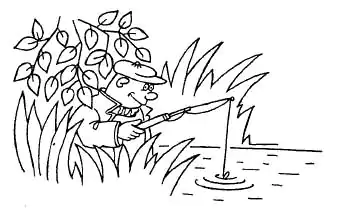
The type of fish that can be caught depends on what kind of bait you put on the jig hook. These are pike perch, perch, roach, rudd, bream, chub, grayling, trout and even pike. A light wave and ripples perfectly help the action of the jig.
361. When fishing with a jig, the rod can be two- or three-legged. A fishing line with a diameter of 0.25-0.30 mm should be equal in length to the rod, a leash - 0.15-0.25 mm, a jig with a hook No. 3.5-4. When fishing for whitebait, use a jig with hook No. 5-6. The jig is tied vertically to a universal leash with a pin and removable balls. No additional sinker required.
362. The jig with bait should sink to the bottom and be 5-10 cm from it. When fishing in calm water, twitch the tip of the rod while pulling the float. This achieves good jig play.
363. When fishing from the shore, use a two-legged rod of normal flexibility with a guard at the tip. The guard should be equipped with a light wire reel, fishing line 0.25-0.30 mm, and a leash 0.15-0.25 mm. Select a jig of such weight that it can pull the line through the guide rings.
364. The jig with bait is pulled to the guardhouse, the rod is lowered to the water, into the selected “window”. Then, unwinding the line from the reel, let the jig sink to the bottom. The reel is put on the brake. Vibrating the tip of the rod forces the jig to play. This type of fishing is successful on hot sunny days, when the fish is looking for shade and coolness. This method is used to catch bream, chubs, perches and roaches.
Fishing by swimming
336. A floating fishing rod should be rigid and durable (juniper or bamboo). The length of the rod is at least 3 meters, the thickness of the upper part is 6-8 mm, 4-5 guides, a reel or reel. Strong fishing line (braided nylon cord or vein 0.5-0.6 mm thick) up to 30 meters long. The float can be white, plain or sliding; load - from 8 to 12 g, a strong leash 25-30 cm long, connected to the fishing line with a carabiner. Hooks are either large single hooks or tee-anchors No. 3-5 - they will withstand the load when catching the largest fish.
337. Large predators are caught by swimming using live fish attached to a tackle. The boat can be equipped with up to three fishing rods. The distance from the live bait to the float should be approximately half the depth of the reservoir. When fishing with three fishing rods, one bait fish attached to a hook is lowered over the starboard side, the second over the left, and the third over the stern. The boat begins to move slowly with the current, and the fishing line with live bait is gradually released. You need to bait the bait so that it moves head first when moving. When casting live bait away from the boat, you can use a sliding float. When fishing by swimming, they look for pike perch in river holes, snags, and in deep reaches. They are caught in the morning, evening and at night in the summer. Live bait for pike perch is chosen with a small, square build. They hunt for catfish in September, go fishing in the evening, look for it in holes and on stretches. Frog, fish, and shell meat are used as bait.
338. You can successfully fish by swimming in livestock watering areas. During the warm summer months, a lot of fish accumulate just downstream from the watering hole. Animals shake off flies, gadflies and horseflies, which so attract fish. The herd is brought in in the morning and evening, at certain hours, and the fish, having quickly learned this, feed in such places.
339. To ensure successful fishing, adhere to strict equipment recommendations. Large fish take bait when releasing it far away. The rod is about 3 meters, the thickness of the elastic tip is 3-4 mm, a light wire reel, fishing line with a diameter of 0.3 mm, a leash 75-150 cm long, made of fishing line 0.2 mm thick. The float is small, oblong in shape. The size of the hook depends on the type and size of the bait (No. 6-7), with a straight bend and a short shank. In case of strong current, the float is attached 150 cm from the hook. The bait should swim in front of the float.
Which floats to choose
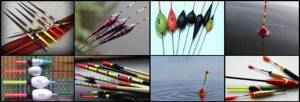
Floats come in a variety of shapes, weights, colors and uses. If we talk briefly about floats, the lighter the float, the better the bite is visible and the more often the fish will bite, but light floats are problematic to cast far, especially in strong winds. Read in detail about the choice of floats at the link, where we explained everything in an accessible and informative way.
We also wrote the following interesting reviews:
- Floats for current
- Floats for night fishing
- Floats for catching crucian carp
- Making floats with your own hands
Groundbait and bait for fishing rods
Proper baiting of the fishing spot always improves the fishing result. I divide the bait into two steps. The first, preliminary step is the starting feeding of the place before starting fishing. This is the most abundant feeding, designed to attract fish swimming “somewhere out there”. The average quantity is 5-10 balls the size of an orange. The second step is supplementary feeding during fishing. It involves feeding fish that have already swam and is designed to keep it at one point (namely where we fish). Perform every 10-15 minutes with one ball the size of a chicken egg.
Constant feeding of one place has a very good effect. Already on the third day it was possible to attract large bream and carp in this way.
Types of float gear
The gear is arranged in order of popularity and ease of use among recreational fishermen.

Fly fishing rod - a light rod 4-7 meters long is used without the use of a reel (although you can use a small drum to store fishing line). The rig is thrown into the water with a wave of the hand, which is why the fishing rod is called a fly rod.
Match fishing rod - a 4-6 meter long rod with a spinning reel is used, which is used for long casting. In such fishing, blind or sliding equipment is used.
Plug fishing method - this type of fishing is the most difficult, but at the same time the most effective. For fishing, long rods are used, which in “combat” condition reach a length of 12-18 meters.
The equipment is fed directly to the baited fishing spot; this is achieved by extending a long rod that rests on a special plug stand. The plug rod allows you to deliver the bait very accurately to the feeding spot.
This type of float fishing is very difficult, but very effective; it is usually fished with a pole by experienced fishermen.
Read about how to choose a float rod in a separate article at the link, where you will find a detailed overview of all types of float rods.
